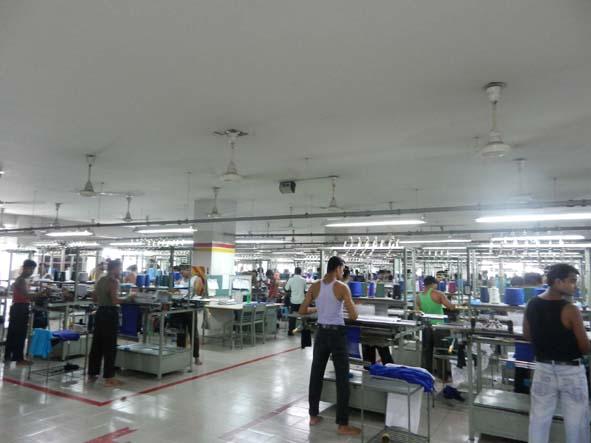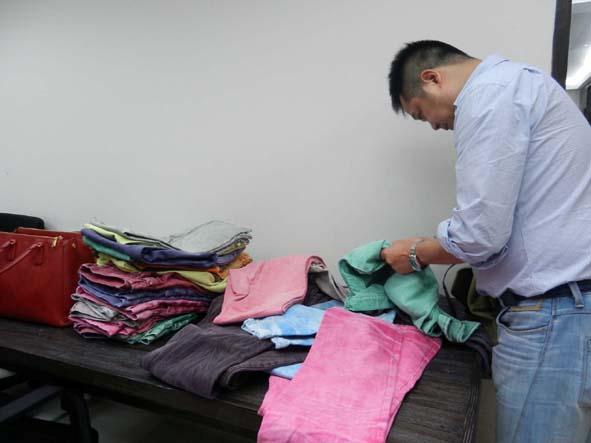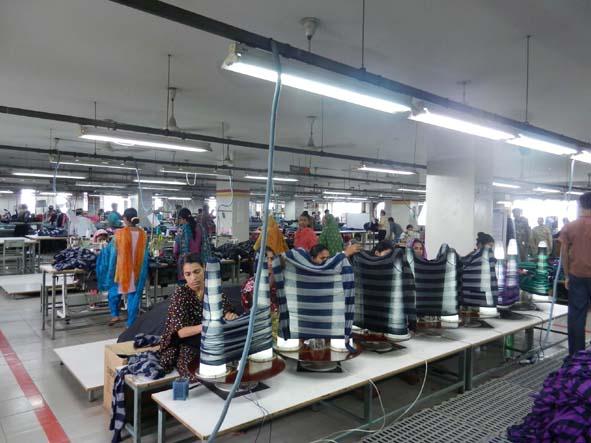Time: 2012-10-12 08:00:00

Investigation Report on Bangladesh's Garment Industry
1、Overview of Bangladesh's Garment Industry
The delegation visited the Bangladesh Garment Manufacturer and Exporter Association (BGMEA) during its stay in Bangladesh and visited several factories under BGMEA's arrangement. These factories have reached a certain size. The delegation was deeply impressed by their advanced equipment and standard management and the CNGA leaders and Chinese enterprises began to have a new understanding of the textile and garment industries in Bangladesh.
As an up-rising star in the textile industry of Asia, Bangladesh continuously improves its competitiveness of textile and garment products in the international market in recent years. According to the statistics of WTO, the gross garment export from Bangladesh reached US$ 15.66 billion in 2010, ranking the third in the world, only second to China (US$ 129.84 billion) and European Union (US$ 22.31 billion). Due to the long history of the textile industry in Bangladesh, and the reasonable and orderly textile industry development strategy promulgated by the government, Bangladesh is becoming increasingly a big textile country in Asia, with its development level of textile industry even higher than that in China in 1990s.

2、Development Status of Bangladesh's Textile and Garment Industry
① Large industrial size and advanced factory facilities
After 30 years of development, Bangladesh's textile and garment industry has reached a considerable size and a comparatively complete industrial chain has formed. The factories are furnished with good internal environment, advanced equipment and facilities, standard management, and relatively high production efficiency. The factories serve many world-known brands such as Zara and H&M providing OEM products. The enterprises are equipped with complete product testing equipment and put international quality inspection standards into practice strictly to be in line with international markets. Now, Bangladesh's garment factories are capable of processing various products such as jeans, T-shirts, casual garments, and children's garments. Even high-end T-shirts and jeans can meet the demands. However, the factories are relatively weak in processing of suits, western-style shirts, and footwear.
② Good embeddedness
Most textile and garment enterprises in Bangladesh are operated by locals and there are only a few foreign-invested enterprises. The enterprise owners are quite experienced in industrial operation and international cooperation and are well educated. As English is one of official languages, it is smooth to communicate with international traders.
③ Easy management of workers
Most Bengalis believe in Islam. They are unsophisticated and moderate and easy to manage. In addition, more than 80% of the workers are female, who observe disciplines and are highly efficient. None of the factories at present in Bangladesh provides workers with accommodations.
④ A strong sense of corporate social responsibilities
At the request of the international purchasers, Bangladesh's garment enterprises have established complete social responsibility system. The enterprise pays attention to their employees and the society, providing various life conveniences to their employees. For example, kindergartens and clinics are furnished in the factory. During the work hours, the female workers can send their children to the kindergarten furnished in the enterprise and have lunch with them. In this way, the female workers are relieved of family considerations and a large amount of productivity is released, which are more beneficial to social stability.
⑤ Advanced processing technology
Bangladesh's garment enterprises are equipped with advanced equipment and high processing technology. Now the textile and garment factories already have various kinds of processing technology such as water washing, tie dyeing, dip dyeing and snowflake washing, and they are also able to undertake the processing of various garment products.
3、Conclusion
To sum up, we suggest that China establish a strategic partnership with Bangladesh's textile and garment industry, to enhance the ability of Chinese garment enterprises in integrating international resources. Some brand enterprises may shift their orders of middle and low-end products to Bangladesh's garment factories, provide materials to them, and import finished products to China, so as to reduce product costs. It takes about 15 days to transport from the Port of Chittagong to Guangzhou, which has little impact on distribution and delivery of the brand products. In the meantime, the construction of a highway from Kunming to Calcutta provides convenience to the cooperation between China and Bangladesh's textile and garment enterprises. According to our estimate, the transport price accounts for only 3% of the EXW price. The total production cost in Bangladesh is 50% - 60% of that in China.

Investigation Report on Cambodia's Garment Industry
During the stay in Cambodia, the delegation met the Garment Manufacturers Association of Cambodia. They also visited two garment factories invested by Chinese businessmen in Phnom Penh and Sihanoukville Special Economic Zone in Sihanoukville Province of Cambodia.
1、Overview of Cambodia's Garment Industry
Since 2000, Cambodia has been accelerating the development of its garment industry which has become one of the four pillar industries for the economic development of Cambodia. Now there are more than 500 garment factories in Cambodia and as much as 550,000 employees in this industry. However, most garment factories in Cambodia are purely engaged in processing. All factories are foreign-invested mainly by investors from Taiwan, Japan, ROK, Hong Kong, and China. If Bangladesh's garment factories are large enterprises, those in Cambodia are merely processing workshops. The materials and accessories are basically imported from China. Moreover, the garment factories are mainly concentrated in Phnom Penh and Sihanoukville.
Now Cambodia's garment factories have possessed such technologies as water washing, beading, tie dyeing and embroidery, while without dyeing and finishing capacity.
2、Investment Advantages of Cambodia's Garment Industry
①、Safe investment environment
Cambodia is politically stable in recent years. 90% of its people believe in Buddhism. The people are simple and moderate, and there is no racial conflict.
②、Stable and firm Sino-Cambodia relationship
Chinese and Cambodian governments have maintained a long-term sound friendship. Cambodia has a large economic circle of Chinese nationals. Therefore, there is little difference from Chinese culture.
③、Loose international trading environment
Cambodia has never encountered trade barrier or anti-dumping investigation since its entry into the WTO in 2004. It is entitled to special trade benefits and extra tariff reduction and exemption granted by developed countries. After the establishment of the Sino-ASEAN Free Trade Zone, ASEAN will also set up free-trade zones with ROK, Japan, India, New Zealand, and Australia, which means that the products originated in Cambodia can flow tariff-free into 10 + 6 markets of ASEAN.
④、Abundant labor and low employment costs
Cambodia has a population of more than 14 million, 62% of which are at the working age of 15 to 60. Therefore, it abounds in labor. Employment costs are low in Cambodia. The minimum wage standard is US$ 61 per month (six days a week). Employment costs of Cambodian FOB factories approximately account for 10% of the total costs. Nevertheless, there are a small number of FOB factories in Cambodia, most of which are only engaged in processing.
⑤、Low cost of factory operation
Apart from low employment costs, Cambodia's garment factories have low operation costs. Owing to the low standard for wastewater treatment in Cambodia, the factories generally use river water for production and the wastewater treatment fees are low.
⑥、Highly free market economic environment
All investors, regardless of their nationalities and races, are legally equal, except for the provisions on land ownership in the Constitution of the Kingdom of Cambodia. The royal government will not implement nationalization policies that will harm the interests of investors. For the approved projects, the royal government will not subject their product prices and service prices to control.
⑦、Free and convenient foreign exchange policy
The Government of the Kingdom of Cambodia will not implement foreign exchange control and allows free flow of foreign exchange funds.
⑧、Central location in Southeast Asia and wide market influence range
Cambodia's transportation to China is convenient. There are direct flights to Phnom Penh, the capital of Cambodia, from Beijing, Shanghai, Guangzhou, Hong Kong, Nanning, etc.
As for the maritime transport, it takes about 15 days from the Port of Shanghai to the Port of Kompong Som (including customs clearance) and about 13 days from Hong Kong to the Port of Kompong Som (including customs clearance).

3、Conclusion:Considering power consumption and other problems, it is comparatively difficult for Chinese textile industry to invest in the preceding working procedures of Cambodia. It is still immature for Chinese garment enterprises to build factories in or place orders from Cambodia. For more information about Bangladesh and Cambodia, please consult the Industry Department of China National Garment Association.

Add: No. 199, Second Section of Xinhua Road, Haixia Science Park, Wenjiang District, Chengdu Zip:610000 Tel:028-82669999 蜀ICP备13002616号-2